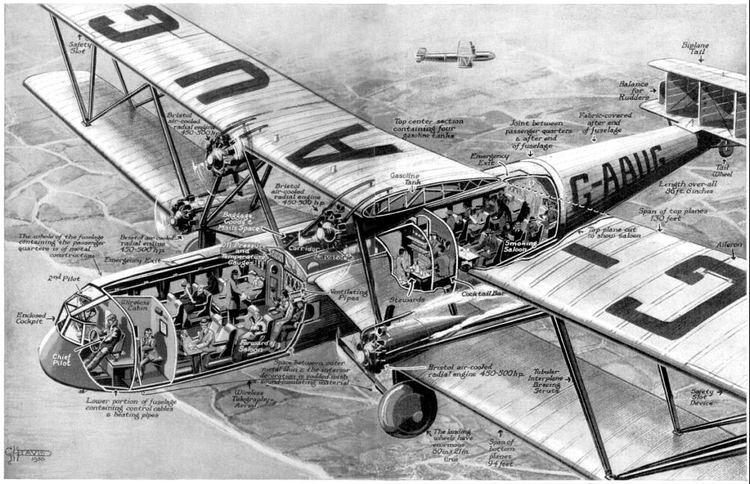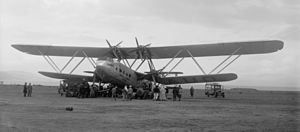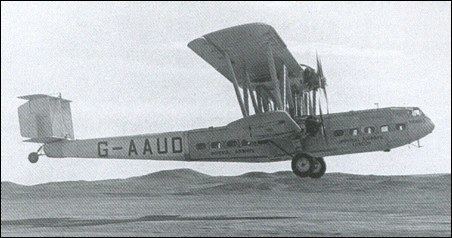Top speed 193 km/h Length 28 m First flight November 14, 1930 | Wingspan 40 m Introduced June 1931 | |
 | ||
Engine types Radial engine, Bristol Jupiter Similar Handley Page Victor, Handley Page Heyford, Vickers Wellington | ||
Handley page h p 42
The Handley Page H.P.42 and H.P.45 were British four-engine biplane airliners designed to a 1928 Imperial Airways specification by Handley Page of Radlett in Hertfordshire. The H.P.42/45 were the land-based backbones of Imperial Airways and along with the airline's later flying boats are well remembered. Eight were built, four of each type; all were named, with names beginning with the letter "H". The three survivors were pressed into Royal Air Force service at the outbreak of the Second World War. No lives were lost in civilian service (a record thought to be unique for contemporary aircraft) but by 1940, all aeroplanes had been destroyed.
Contents
- Handley page h p 42
- Handley page h p 42 airplane type
- Design and development
- Operational history
- Individual histories
- HP42
- HP45
- Operators
- Specifications HP42E
- Notable appearances in media
- References

Handley page h p 42 airplane type
Design and development

The H.P.42 was designed for the long-range Eastern routes and the similar H.P.45 was built for the European routes. Imperial Airways called the H.P.42 the H.P.42E (E for "Eastern" routes - India and South Africa), while the H.P.45 was the H.P.42W (W for "Western" i.e. European routes). The H.P.42 and H.P.45 designations were Handley Page's identifiers but the HP.45 was not commonly used during the flying lives of the aircraft. The H.P.42 was a large unequal-span biplane, all-metal except for the fabric coverings of the wings, tail surfaces and rear fuselage. The wings were braced by a Warren truss. The tailplane was biplane with three fins. The H.P.42 had four Bristol Jupiter XIFs of 490 hp (370 kW) each while the H.P.45 used four Jupiter XFBM supercharged engines of 555 hp (414 kW). Both had two engines on the upper wing and one on each side of the fuselage on the lower wing.

The crew compartment was enclosed—a new development—and there were two passenger cabins, one forward and one aft of the wings. The H.P.42E carried six (later 12) in the forward compartment and twelve in the aft. There was substantial baggage room. The H.P.42W seated 18 forward and 20 aft, with reduced baggage capacity.
Operational history

The first flight was on 14 November 1930, by G-AAGX later to be named Hannibal, with Squadron Leader Thomas Harold England at the controls. The certificate of airworthiness was granted in May 1931, permitting commercial service; the first flight with fare-paying passengers was to Paris on 11 June of that year.

Imperial Airways wanted its airliners to land safely at low speed, which meant a large wing area (almost as much as a 767 that weighs more than 10 times as much). In 1951 Peter Masefield wrote, "The trouble about a slow aeroplane with a really low wing loading is the way it insists on wallowing about in turbulent air ... One of the reasons that seven times as many people fly to Paris to-day, compared with 1931, is that the incidence of airsickness in modern aircraft is only one-hundredth of that in the pre-War types." Another writer remembered "I had quite often been landed in a '42' at Lympne to take on sufficient fuel to complete the flight (from Paris) to London against a headwind — 90 mph was its normal cruising speed." When the H.P.42s were finally withdrawn from civil service on 1 September 1939 they had recorded almost a decade without any major accidents.
Individual histories
Four H.P.42 and four H.P.45 aircraft were delivered, two HP45s being later converted to HP42s.
H.P.42
The H.P.42 was intended for the Africa and India services. They were based in Cairo. In June 1939, RAF pilot Eugene Vielle was dispatched to Cairo to fly an H.P. 42 back to England. He had to wait several months, until December 1939, for spare parts to arrive to get the aircraft into good flying condition. His flight back to RAF Lakenheath, with at intermediate stop at Gibraltar for fuel, was uneventful until he reached the airspace near Lakenheath. As he circled, waiting for other planes in the area to clear the flight path for his landing, his aircraft began to experience engine trouble—possibly due to icing in the engine cowlings due to the frigid winter conditions over Lakenheath—and he was forced to parachute from the aircraft. He landed awkwardly in a sheep farmer's field adjacent the runway, breaking both legs.
G-AAGX Hannibal
The first flight of the prototype, Hannibal, was on 14 November 1930. The aircraft was named after Hannibal Barca, the Carthaginian military commander. On 8 August 1931 the aircraft was operating a scheduled passenger flight from Croydon to Paris when the port lower engine failed. Flying debris from the failed engine struck the propeller of the port upper engine causing it to vibrate so severely that it had to be shut down. A forced landing was made at Five Oak Green, Kent where the aircraft suffered further damage to a wing and another propeller and the tail was ripped off against a tree stump. There were no injuries amongst the 20 passengers and crew. The aircraft was dismantled and taken to Croydon by road for rebuild. It was lost over the Gulf of Oman in RAF service on 1 March 1940 with eight aboard including the First World War ace Group Captain Harold Whistler and the Indian politician Sir A. T. Pannirselvam. An early report that wreckage of the aircraft had been located turned out to be incorrect; no trace of the aircraft, the air mail it carried or its occupants has ever been discovered and the cause of its loss remains unknown.
G-AAUC Horsa
G-AAUC was originally named Hecate after the Greek goddess; it was soon renamed Horsa, after the legendary conqueror of Britain and brother of Hengist. The aircraft first flew on 11 September 1931. It was impressed into No. 271 Squadron RAF as AS981. The aircraft burned after a forced landing on uneven ground at Moresby Parks, near Whitehaven, Cumberland, on 7 August 1940.
G-AAUD Hanno
G-AAUD, production number 42/3, was named after the Carthaginian explorer Hanno the Navigator, who explored the Atlantic coast of Africa in approx. 570 BC. Hanno first flew on 19 July 1931 and was later converted to a H.P.42(W) (Hannibal class). The aircraft was impressed into No. 271 Squadron RAF and was destroyed in a gale at Whitchurch Airport, Bristol when it was blown together with Heracles and damaged beyond repair on 19 March 1940. This aircraft was featured in the fifteen minute 1937 Strand Film Company documentary Air Outpost.
G-AAUE Hadrian
G-AAUE, production number 42/2, was named after the Roman emperor Hadrian. Hadrian's first flight was on 24 June 1931. On the outbreak of the Second World War, Hadrian was impressed into No. 261 Squadron RAF as AS982, at RAF Odiham. On 6 December 1940, Hadrian was torn loose from its moorings at Doncaster Airport in a gale, cartwheeled, and ended up inverted on a railway track next to the airport. The aircraft was too badly damaged to be worth repairing. The aircraft made a brief appearance in the 1936 movie Song of Freedom starring Paul Robeson.
H.P.45
The H.P.45 carried more passengers with a reduced range and baggage capacity, and was intended for Imperial Airways' European routes.
G-AAXC Heracles
G-AAXC was named after Heracles, also known as Hercules, who was the son of Zeus and Alcmene in Greek mythology and was noted for his extraordinary strength. Heracles first flew on 8 August 1931 and was impressed into service with the RAF on 3 March 1940. The aircraft was destroyed in a gale on 19 March 1940 at Whitchurch Airport, Bristol, when it was blown together with Hanno and damaged beyond repair.
G-AAXD Horatius
G-AAXD was named after Horatius, a legendary Roman hero. Horatius first flew on 6 November 1931. On 9 December 1937, Horatius was struck by lightning whilst flying across the Channel from Paris to Croydon. A precautionary landing was made at Lympne where it was found that minor damage had been done to a wing. In September 1938, Horatius suffered damage to its port undercarriage and lower port wing in a forced landing at Lympne. The aircraft was repaired and returned to service. It was impressed into RAF service in the Second World War. Returning from France on a transport mission on 7 November 1939, the aircraft could not find its destination of Exeter due to bad weather and was forced to make an emergency landing at Tiverton Golf Course; during this, it hit two trees and was destroyed. A four-bladed wooden propeller from the aircraft was salvaged and is now on display at the Croydon Airport Visitor Centre, situated in the former terminal building of Croydon Airport.
G-AAXE Hengist
G-AAXE was originally named Hesperides, but was soon renamed after Hengist, brother of Horsa and legendary conqueror of Britain. Hengist first flew on 8 December 1931. It was later converted from a European to an Eastern aircraft. Hengist was caught in an airship hangar fire and burned at Karachi, India on 31 May 1937, making it the only H.P.42/45 not to survive until the Second World War.
G-AAXF Helena
G-AAXF was named after Helena, also known as Helen of Troy. It first flew on 30 December 1931. Like Hengist, it was converted to an Eastern aircraft. Helena was impressed into service with No. 271 Squadron RAF in May 1940 . After a hard landing the aircraft was grounded later that year; post-accident inspection condemned the airframe due to corrosion, and it was scrapped in 1941, except for the front fuselage section which was used as an office by the Royal Navy for several years. Parts of this plane can be seen in the 1933 film The Solitaire Man.
Operators
Specifications (H.P.42E)
Data from Handley Page Aircraft since 1907
General characteristics
Performance
Notable appearances in media
The H.P.42 features in Roy Lockwood's 1934 short documentary film Airport (a "day-in-the-life" of London's Croydon Airport).
A fictional H.P.42 is the setting of Agatha Christie's Death in the Clouds.
An H.P.42 appears in a scene in Kiki's Delivery Service.
